Yoshimura history – 18
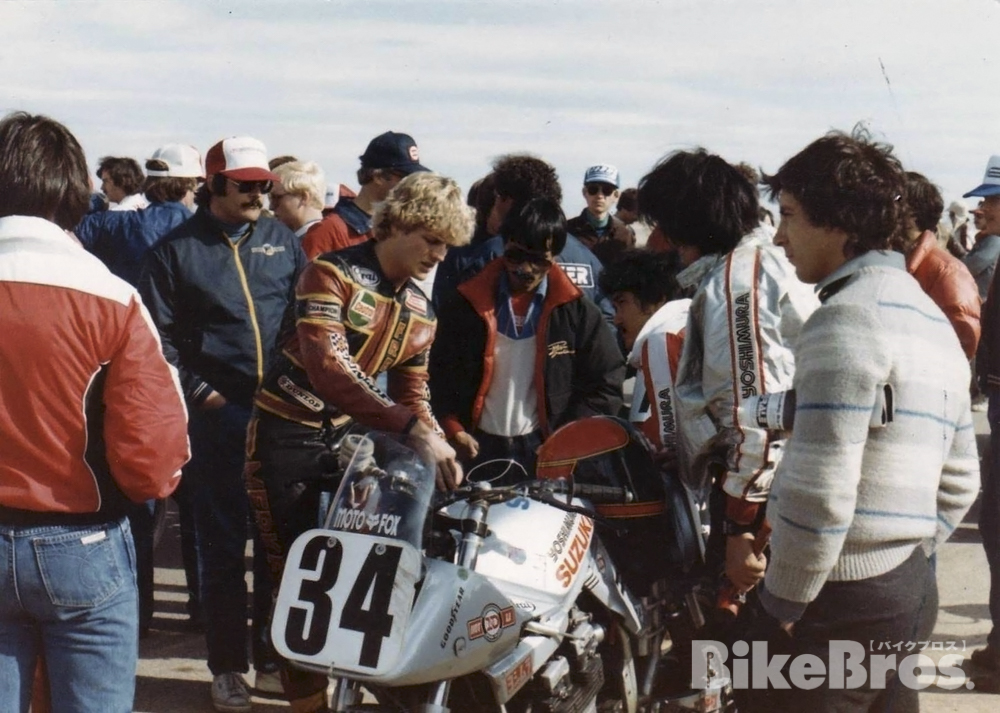
As the 1982 AMA Superbike season concluded, Yoshimura entered Cooley’s AMA-spec GSX1000SZ Katana Superbike (notice the #34 plate) in two local SoCal races hosted by AFM —- at Willow Springs in November 28 and at Riverside in December 10 —- and Fujio (in the middle wearing sunglasses) hired a young local rider Fred Merkel (left, age 20 at the time) to race it. Markel later joined American Honda and won the 1984-1986 AMA Superbike championship (on a VF750F and then on a VFR750F) as well as the inaugural and second-year FIM Superbike World championship (on a RC30) which began in 1988.
Yoshimura History #18: From the 8V GS to the 16V GSX Katana
16-Valve 152hp Katana Debuts
Yoshimura R&D achieved the best possible result in the 1981 AMA Superbike season-opener at Daytona, with a 1-2 finish by Wes Cooley and Graeme Crosby. In the rest of the Superbike season, however, Cooley and his GS1000S (1023cc with φ70.9×64.8mm) failed to win a single race against Eddie Lawson (aboard his US Kawasaki KZ1000J) and Freddie Spencer (aboard his American Honda CB900F). Lawson won his first championship that season with 4 wins, and Freddie Spencer finished 2nd in the ranking with 3 wins, while Cooley, with only 1 win, had to settle for 3rd in the ranking.
For the Suzuka 8 Hours, the GS1000 engine was installed into a new chassis consists of a double-cradle steel frame, an aluminum swingarm, and a mono rear shock (Full Floater system with both the upper and lower shock mounts on the swingarm unit). The bike was put into the hands of the mighty duo, Crosby and Cooley. However, on Lap 58, the engine blew at the last corner. Crosby crossed the finish line, pulled the bike over to the pit wall, shouted something to the Yoshimura crew, and pushed the bike backwards down the pit lane. Pop decided to retire the race as he noticed the oil pouring out of the bike’s cylinder block. Official result was: retired at Lap 58 with a broken crankshaft.
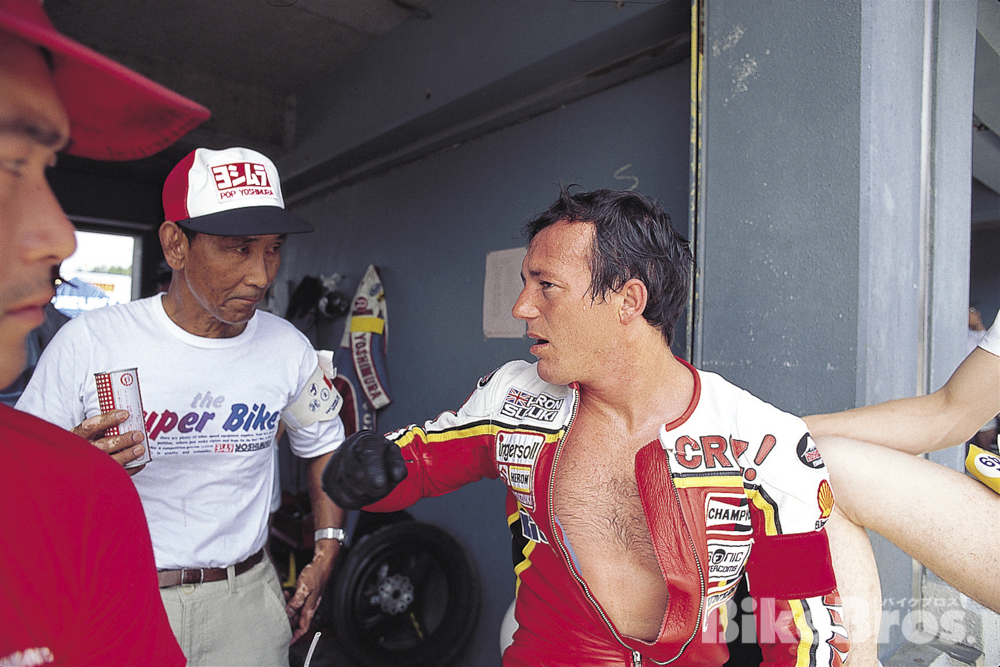
The star of the 1981 Suzuka 8 Hours was not Graeme Crosby (right), but the gem that Mamoru Moriwaki had unearthed in Australia, Wayne Gardner. In the qualifying, Crosby tried his best, but could not reach Gardner by 1.11 seconds. Although he lost, Pop (left) was enjoying watching the battle between the two, as Crosby had competed against Yoshimura —- Cooley and Baldwin —- in the same way when he made his debut with Moriwaki as a rookie Kiwi rider in 1978.
It was not Yoshimura but their relative Moriwaki that attracted the most attention at the 1981 Suzuka 8 Hours. Riding the innovative double-cradle aluminum-framed, twin-shocked, Kawasaki Z1000J-powered Moriwaki Monster, Aussie newcomer Wayne Gardner took pole position with a TT-F1 lap record of 2:14.76, shaving 1.48 seconds off the previous record (2:16.24 set by Kengo Kiyama on a Honda RS1000). Crosby tried his best to challenge Gardner, but the best lap time he could turn in was 2:15.75. Gardner was just 1.11 seconds shy of the Suzuka lap record at the time (2:13.65 set by Ikujiro Takai on a Yamaha YZR500), which was incredible considering how close he was to the record set by a 2-stroke GP500 bike while riding a 4-stroke production-based TT-F1 bike.
Mamoru Moriwaki was in tears of joy, and Pop shouted to Gardner, “You are fucking fast. Go back home!” Gardner at first wondered who the hell was yelling in dirty language, but when he realized that it was Pop Yoshimura himself, he burst out laughing. In the race, Gardner was forced to retire from the race after crashing on the Spoon Curve on Lap 60, and in the end, the 1981 Suzuka 8 Hours was won by Honda France RS1000 ridden by Mike Baldwin / David Aldana, who both happen to have a connection with Yoshimura.
November 22, 1981 was a very sad day for the Yoshimura family when Shohei Kato, the husband of Pop’s second daughter Yumiko —- and the father of Yoshimura race director Yohei Kato —- was killed in an accident at Suzuki’s Ryuyo test track. He was testing a GS1000R that day when he crashed on a high-speed corner. He did not suffer any broken bones in the fall, but instead drowned in water that had accumulated in an irrigation ditch on the side of the track.
His wife, Yumiko, was speechless and had no memory of the day of the incident. Pop regretted not being there for the test, felt responsible and at one point thought about quitting racing. But then he thought, how could such a great man die so young? If I quit, what will happen to the will of Shohei? We have to get over it, Pop vowed to himself.
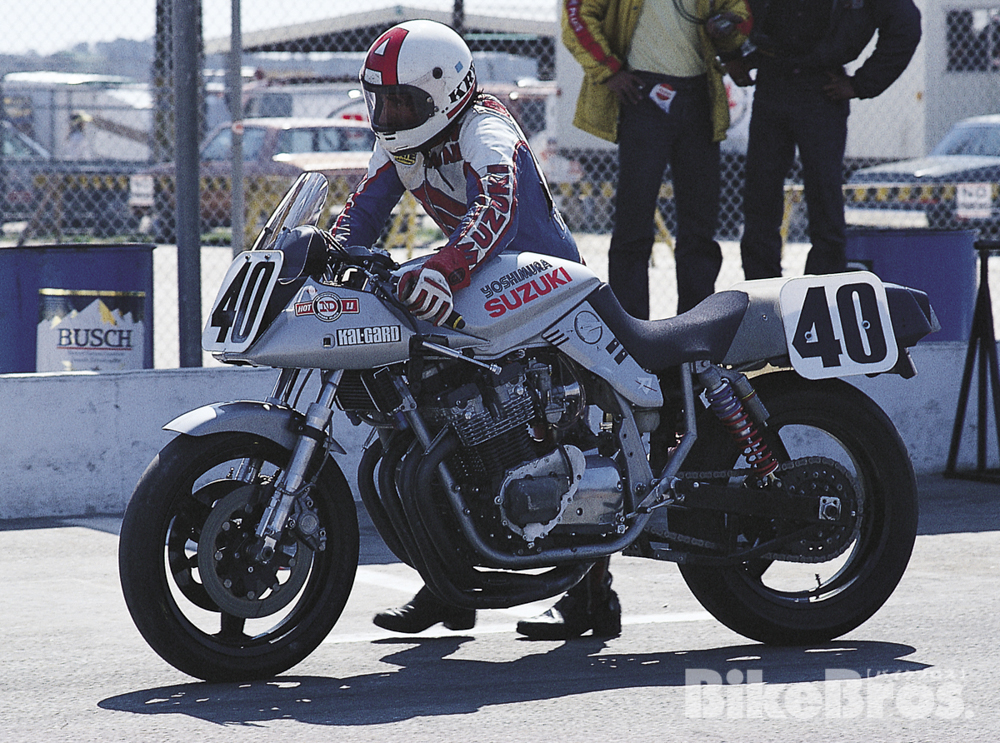
The AMA-spec Yoshimura Suzuki GSX1000SZ Katana, equipped with φ40mm KYB ANDF forks and lay-down Fox shocks (ride height is also increased, aka “kachiage”). The swingarm is square-tube aluminum construction with underbracing. The carbs are Keihin CR’s (as at Daytona). The exhaust is regular 4-1 configuration with an aluminum silencer.
In 1982, the DOHC 16-valve (4-valve per cylinder) Suzuki GSX1000S Katana / GSX1000SZ Katana were introduced to replace the DOHC 8-valve (2-valve per cylinder) GS1000. The GSX1000S (Euro-spec with VM carbs) and GSX1000SZ (US-spec with SU carbs) were homologation models to compete in TT-F1 and AMA Superbike, with engines bored down to 998cc (φ69.4x66mm) from GSX1100S Katana / GSX1100 E’s 1075cc (φ72x66mm). However, Suzuki France (now SERT: Suzuki Endurance Racing Team) which competes in the FIM EWC (Endurance World Championship), was supplied with the 8-valve GS1000 engines (Yoshimura-tuned, of course) due to their reliability.
The 16-valve Katana was superior to the 8-valve GS in terms of maximum output, but it also had many issues, such as heat build-up, heat distortion and fragility of pistons. Even so, the Katana was tuned to produce approximately 145ps (an increase of around 10ps over the GS) before the Daytona Superbike opener. However, at Daytona, the Katana continued to have issues. Cooley’s Katana suffered piston seizures after just a few laps, forcing him to switch to a 8-valve GS1000S for the qualifying session, while Aldana’s Katana had its engine blown up during the qualifying session, which saw him withdraw from the main race.
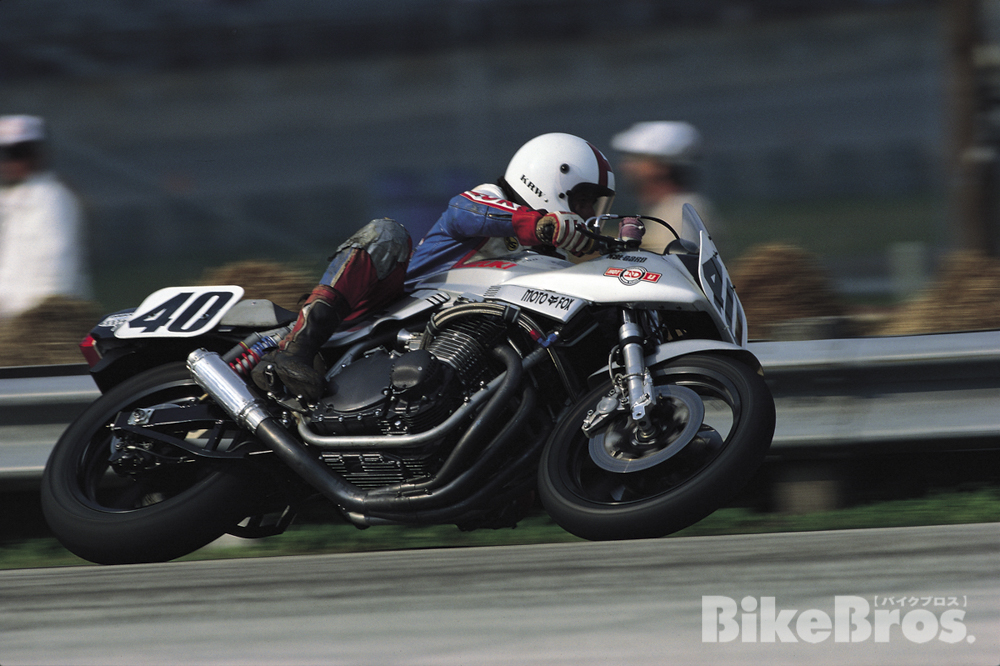
March 1982, Daytona. David Aldana aboard Yoshimura Suzuki GSX1000SZ Katana going through Turn 1, from the 18-degree bank in front of the grandstands to the infield. Since Cooley had to change his bike to a 8-valve GS1000S and Aldana had to withdraw from the race, the Yoshimura Katana’s debut race ended with no result.
In the main race on Friday, March 5, Cooley did well to finish 4th, but the American Honda CB750F’s dominated Victory Lane with a 1-2-3 finish (Freddie Spencer, Mike Baldwin and Roberto Pietri, in that order). The CB750F’s pulled away quickly from Cooley’s GS1000S on the 31-degree bank, without even letting him use drafting. It was time to move forward from the GS by making Katana podium-worthy, and Yoshimura must accomplish it at all costs. The 1982 AMA Superbike Round 2 at Talladega (Alabama International Motor Speedway) took place a week later on March 14, but Cooley aboard Katana retired from the race after only 3 laps with a broken piston.
Fujio flew to Stuttgart, Germany after the Talladega round. His destination was the prototype factory of the renowned piston manufacturer Mahle, and his plan was to upgrade Katana’s pistons from cast aluminum to forged aluminum, to increase their strength. The factory was run by only 3 persons (grandfather, father and son) and their equipment was old-school, but it was known that they had been producing pistons for aircraft engines (for Messerschmitt fighters) since before the war, so their level of craftsmanship is up there with the best of the best.
The resulting forged aluminum pistons were as great as they could be, and their thermal strength was dramatically improved, solving the piston breakage issues. Cooley finished 4th in Round 3 at Riverside on April 18, right after the Mahle pistons were installed into his Katana. He then finished 2nd in Round 4 at Elkhart Lake (Road America), 4th in Round 5 at Loudon (Bryar), 3rd in Round 6 at Monterey (Laguna Seca), 7th in Round 7 at Long Pond (Pocono), 5th in Round 8 at Sonoma (Sears Point), 2nd in Round 9 at Kent (Seattle), retired in Round 10 at Daytona, but finished 3rd in Round 11 at West Palm Beach (Moroso), showing consistent performance throughout the season.
Cooley also raced a GS1000R —- steel frame with Full Floater rear suspension, 1023cc displacement with φ70.9×64.8mm —- in the AMA Formula One class (1025cc 4-strokes and 750cc 2-strokes) that season. The 8-valve GS engine continued to demonstrate great potential, and on May 23 in 1982 Formula One Round 2 at Elkhart Lake, Cooley scored a round-win which brought him up to 3rd in the ranking. The champion was Baldwin aboard his liquid-cooled V4-engined monster, Honda RS1000RW (FWS1000).
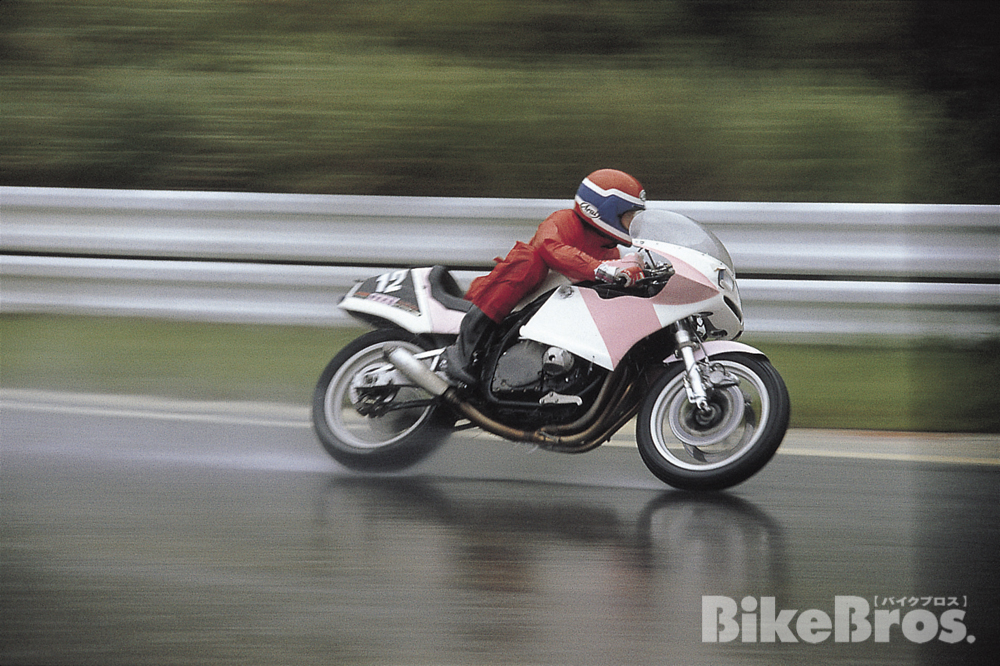
Cooley piloting Testarossa 1000R on the river-like racetrack. Hidden under his rainwear and rubber overboots was the gorgeous pink & white leather race suit tailored by Kushitani. The Testarossa 1000R featured a double-cradle steel frame, a monoshock suspension, an overbraced square-tube aluminum swingarm and a 150ps GSX1000S engine.
The 1982 Suzuka 8 Hours endurance race was shortened to 6 hours due to a direct hit by a typhoon. In the terrible wet condition, it was like riding in a river. The pink & white Testarossa 1000R (powered by a GSX1000S engine, ridden by Cooley / Aldana), entered by Team Italya Sport Yoshimura R&D, started from the 4th position in the qualifying. Although struggled a little during the race as Aldana hydroplaned and crashed on the straight by the grandstand, the team managed to finish the race in 6th place. The bike was not the fastest even in dry qualifying. The first qualifier was, ironically, Suzuki France’s 8-valve GS1000R.
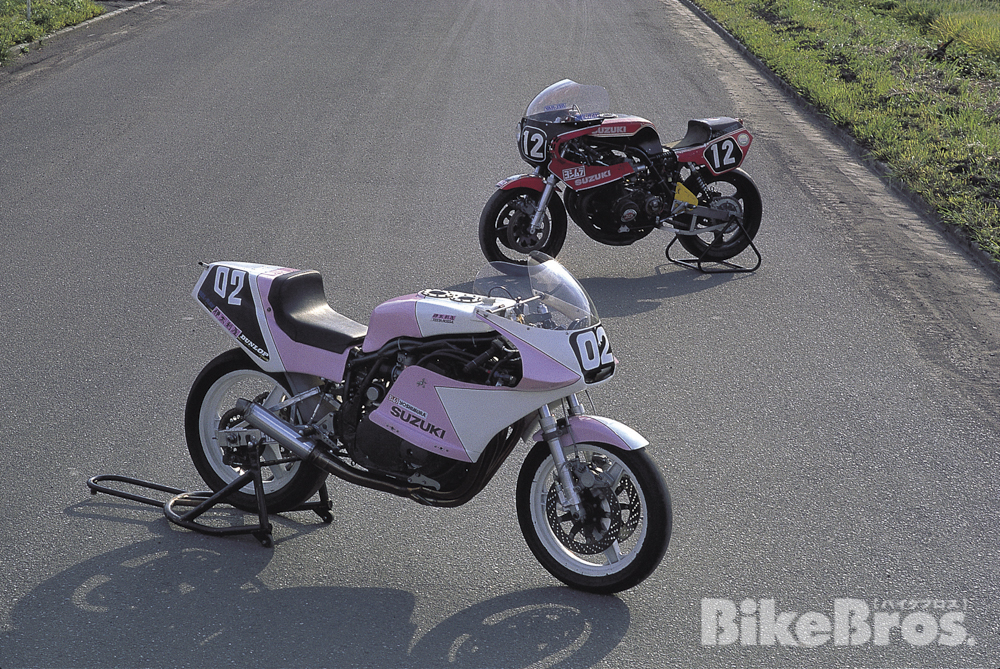
The Testarossa 1000R for 1982 Suzuka 8 Hours was powered by a TT-F1 spec GSX1000S engine, and painted in shades of pink and white which was the color scheme of Japanese fashion brand Italya. A bike in “full sponsor colors” were very rare at the time. Seen behind is the 1980 Suzuka 8 Hours winning #12 Yoshimura Suzuki GS1000R (XR69).
Fujio was far from being satisfied. The development time for the Yoshimura Katana race bike was so short that it was actually done after the season started in April. The forged Mahle pistons solved some issues, but the Katana still had so many problems. One of them was the geometry of the valve train. Unlike the direct-acting system used on 8-valve GS and Kawasaki Z, the rocker-arm system used on Katana (1 rocker arm operating 2 valves) has a high leverage ratio, and the camshafts and rocker arms were prone to scuffing. Also, the engine was wider and heavier than that of the GS, and had no advantage in lean angle or handling, whether on the stock-frame Superbike or the TT-F1 chassis.
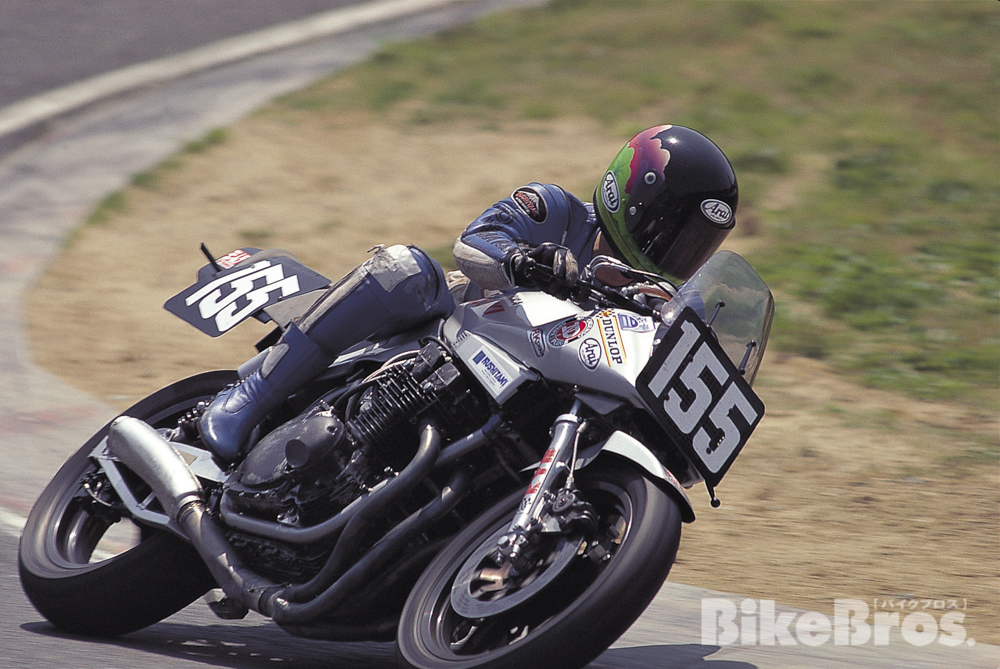
The Superbike-style GSX1000SZ Katanas were entered in numerous competitions ranging from the Suzuka 8 Hours (Norihiro Mikami / Takumi Ito) to the MCFAJ Road Race series (at FISCO, by Noriaki Sakata and others). Many of them were fitted with a Yoshimura Cyclone exhaust and a curved “banana” aluminum silencer.
Fujio then decided to enter Yoshimura Katana —- AMA-spec 1024cc GSX1000SZ —- in the top category of local SoCal AFM (American Federation of Motorcyclists) road race which, unlike the AMA Superbike, is an unlimited displacement class. His choice of rider for the event was not Wes Cooley but Fred Merkel, the number one rookie who would later join American Honda. Fujio thought that a different rider might bring out a different aspect of the bike.
At AFM Superbike at Willow Springs on November 28, #34 Markel took pole position and won the first of 2 heats —- and set the fastest lap while doing so —- against the more experienced riders such as Mike Spencer (Vance & Hines 1170cc Suzuki Katana), Roberto Pietri (Steve Wise’s American Honda CB750F) and one of the fastest AMA privateers Harry Klinzmann (Racecrafters Kawasaki KZ1000S1). In Heat 2, Markel had a clutch problem and had to retire early, finishing 7th overall. The winner of the day was Klinzmann.
Gaining confidence, Yoshimura then entered Markel and Katana in the AFM Superstreet (Open) class race at Riverside on December 10. This time, Markel got the win by pulling away strongly from Klinzmann, and in the process posted a lap time of 1:28.93, which was 1.14 seconds faster than the course record set by Eddie Lawson (on a US Kawasaki KZ1000R in that year’s AMA Superbike Round 3). “I was quite happy,” says Fujio. “This Katana had 152hp.” This was more than the 150hp of the American Honda CB750F (1023cc with φ68.7x69mm), which was said to be the most powerful bike in the world. Yoshimura R&D placed an advertisement in the Cycle News announcing the course record:
“RECORDS ARE MADE TO BE BROKEN. BY YOSHIMURA.”
The 16-valve Yoshimura Suzuki GSX1000SZ Katana —- the fastest and most powerful monster of the 1025cc era —- was completed at the last minute. If only it was completed a little earlier…. The AMA Superbike was to be run under 750cc regulations starting in 1983.
============================================================
Published on February 18, 2022
Stories and photos supplied by Yoshimura Japan / Cycle World / Tomoya Ishibashi
Written by Tomoya Ishibashi
Edited by Bike Bros Magazines
[ Japanese Page ]
